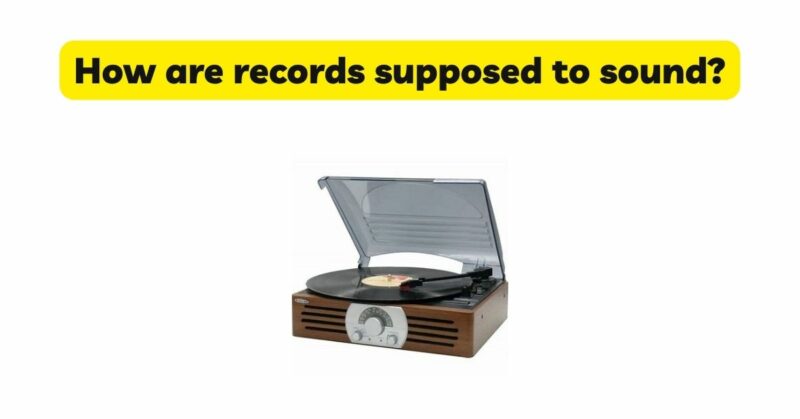Vinyl records have been enchanting music lovers for decades, offering a unique listening experience that combines rich sound quality with a touch of nostalgia. However, the subjective nature of sound perception can sometimes leave enthusiasts wondering how records are supposed to sound. In this article, we will explore the characteristics and qualities that define the sound of vinyl records. We will discuss the warm tonality, dynamic range, presence of pops and crackles, and other nuances that contribute to the distinctive charm of vinyl playback. By understanding the essence of vinyl sound, we can appreciate its unique qualities and fully immerse ourselves in the magic of the format.
- Warm Tonality: One of the defining characteristics of vinyl records is their warm tonality. Vinyl has a unique way of reproducing sound that imparts a sense of depth and richness to the music. The analog nature of vinyl playback allows for subtle nuances and harmonics to be preserved, resulting in a warm and organic sound that many listeners find pleasing. The inherent characteristics of vinyl, including the vinyl material itself, the playback equipment, and the mastering process, contribute to this warm tonality.
- Dynamic Range: Vinyl records have the ability to capture a wide dynamic range, allowing for the reproduction of both quiet and loud passages with clarity and detail. This characteristic is especially noticeable in genres such as classical or jazz, where the dynamic shifts in the music are of great importance. The analog nature of vinyl playback preserves the natural dynamics of the original recording, avoiding the loudness war often associated with digital formats.
- Presence of Pops and Crackles: A unique aspect of vinyl playback is the presence of pops, crackles, and other surface noise. While these imperfections may initially seem undesirable, many vinyl enthusiasts appreciate them as part of the vinyl experience. Pops and crackles can evoke a sense of nostalgia, connecting the listener to the physicality of the medium. They can also add an element of authenticity and remind us of the analog origins of the music. However, excessive noise or pops caused by poor record condition or playback setup should be minimized through proper cleaning, maintenance, and setup practices.
- Vinyl Characteristics: Vinyl records possess certain characteristics that contribute to their distinct sound. The physical grooves on the record hold the encoded audio information, and the stylus, as it travels along these grooves, translates the information into sound waves. The vinyl material itself can introduce subtle distortions, resonances, or surface imperfections, which add to the unique sonic signature of vinyl playback. These characteristics give vinyl its own sonic personality, setting it apart from other formats.
- Analog Warmth and Presence: Vinyl playback is often associated with an inherent warmth and presence that digital formats may struggle to replicate. This warmth can be attributed to the analog nature of vinyl, which preserves the continuous waveform of the original recording. The absence of digital sampling and quantization artifacts allows for a more natural and organic representation of the music. Many listeners find this analog warmth and presence to be engaging and emotionally captivating.
- Listener Engagement and Connection: Vinyl records offer a tangible and immersive listening experience that encourages active engagement. The act of physically handling the record, placing it on the turntable, and carefully lowering the stylus fosters a deeper connection with the music. Vinyl enthusiasts often describe a sense of intimacy and connection to the music that they believe is unique to the vinyl format. This engagement and connection contribute to the overall perception of how records are supposed to sound.
Conclusion: The sound of vinyl records is characterized by warm tonality, a wide dynamic range, the presence of pops and crackles, and other unique qualities that set it apart from digital formats. Vinyl’s warm tonality, dynamic expression, and analog characteristics create a captivating and immersive listening experience. Pops and crackles, though initially perceived as imperfections, are often embraced as part of the vinyl charm, connecting listeners to the medium’s rich history and nostalgia. Ultimately, the sound of vinyl records is subjective and can vary based on individual preferences, playback equipment, and the condition of the records themselves. By understanding and appreciating the unique sound qualities of vinyl, we can fully immerse ourselves in the magic of vinyl playback and enjoy the sonic journey it offers.


